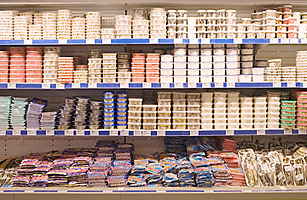
(2 of 2)
And then there's the almighty health claim — labeling that suggests a food component or nutrient helps fight a disease — which is perhaps surrounded by the most front-of-the-box hand waving. That's because companies need regulatory approval for straightforward health claims such as, "Calcium reduces the risk of osteoporosis." To get around the obstacle of approval, which can take more than 500 days to acquire, food makers subtly recraft such statements into what is known as a structure/function claim: "Calcium builds strong bones." (Note the absence of a mention of a disease.) Ask your average shopper, however, and chances are, he or she could not distinguish between the two.
Healthier Reform
In addition to its systematic review of current labeling and marking practices, the FDA has been cracking down on violators in recent months: in February, the agency sent warning letters to 17 companies, including Dreyers, demanding corrections to obvious cases of misleading product labels. It is unclear, however, whether the agency will go so far as to eliminate certain labeling loopholes, such as the structure/function claim. In an email statement to TIME, Siobhan DeLancey, a spokeswoman for the FDA, writes that "existing regulations already require that claims be truthful and not misleading, and we have taken enforcement action against manufacturers who are not in compliance."
Meanwhile, Congress has pledged $500,000 to the Institute of Medicine (IOM) for a detailed study of various front-of-package nutrient-profiling systems used worldwide. One promising program, called Traffic Light, which was developed in the U.K. by the national Food Standards Agency, uses a color-coded scheme to indicate at a glance the amount of fat, saturated fat, sugars and salt contained in a food (red for high, amber for medium and green for low). British supermarkets that have instituted the labeling system report that shoppers tend to purchase products bearing more green dots than red.
A similarly uniform system could be put into place in the U.S. "We at FDA have been spearheading an effort with our colleagues in government and outside to develop a system for front-of-pack nutrition labeling that will be evidence-based, easy to read...and provide clear and consistent guidance for making healthy food choices," said FDA Commissioner Margaret Hamburg in a speech on Wednesday. The IOM's final report expected in 2010 — as well as public comment — will inform the agency's decision.
If It's Broke, Don't Fix It
By developing a voluntary national system for package-front labels, the FDA intends to make healthy eating easier. "For better or for worse, I think we all want to be able to scan and absorb nuanced information about our food as quickly as we scroll through e-mail on our BlackBerrys," Hamburg said. But some experts argue that simplified labeling may do more harm than good in the long run.
At-a-glance labels assume that the consumer is too ignorant to make an informed decision, says Harvard's Ludwig. The solution should be to offer more, not less, information. Ludwig says improved nutrition education would help consumers fully understand Nutrition Facts panels and choose better foods. "It's good to be simple, but not too simple," says Ludwig. "Food choices are too complicated to be reduced to simply green, amber or red."
Ludwig and New York University professor of nutrition Marion Nestle go further, suggesting an outright ban on all front-of-package claims. That would "encourage the public to eat whole or minimally processed foods and to read the ingredient lists on processed foods," the co-authors wrote in a commentary published in the Journal of the American Medical Association in February.
Indeed the recently passed health-care bill calls on the FDA to set a national standard for instituting calorie and fat labeling on restaurant menus. Under the ruling, chain restaurants with at least 20 locations, as well as vending machines, would be required to display nutritional information prominently. The hope is that more and better information will help lead to better choices.